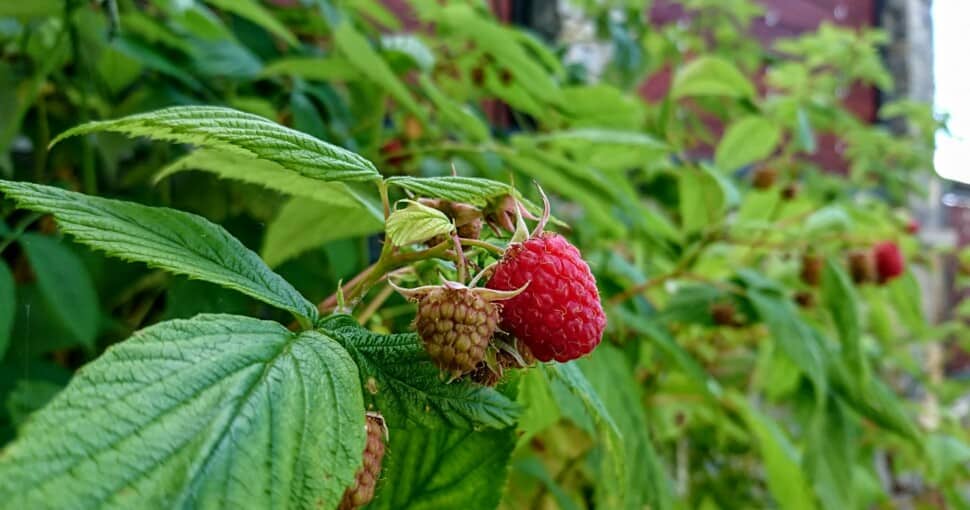Raspberries (Rubus idaeus var.) are some of the most common berries in America since they are native to parts of North America. Raspberries are delicious, aggregate berries with a tangy hint. Often eaten fresh or used in various desserts, most people are happy to have a raspberry bush growing in their garden.
Contents
- 1. Cloudberries (Rubus chamaemorus)
- 2. Red Mulberries (Morus rubra)
- 3. Thimbleberries (Rubus parviflorus)
- 4. Strawberry Madrone Trees (Arbutus unedo)
- 5. Kousa Dogwood Trees (Cornus kousa)
- 6. Salmonberries (Rubus spectabilis)
- 7. Virginia Creeper (Parthenocissus quinquefolia)
- 8. Blackberries (Rubus armeniacus)
- 9. Japanese Wineberry (Rubus phoenicolasius)
- 10. Loganberry (Rubus loganobaccus)
- 11. Red Currant (Ribes rubrum)
Depending on their variety, raspberries can be red, purple (black), or golden. The raspberry plant can grow up to 6 feet high. The plant has alternate, compound leaves with serrated edges and 3 or 4 leaflets per stem. The undersides of the leaves are slightly furry and white. The raspberry tree has thorns.
Regardless of how many unique characteristics a raspberry bush has, some other plants and berries resemble raspberries, including:
- Cloudberries – the berries look like immature raspberries
- Red mulberries – the fruit resembles raspberries
- Thimbleberries – the fruits look like raspberries
- Strawberry madrone trees – the fruits somewhat resemble raspberries
- Dogwood trees – the fruit looks like raspberries
- Salmonberries – the fruit looks like golden raspberries
- Virginia creepers – the plant somewhat resembles a raspberry bush
- Blackberries – the plant and fruit look like black raspberries
Since these plants resemble raspberries, it’s essential to know how they differ. As some berries are poisonous, knowing the difference can save a life. See the list below for information regarding the similarities and differences between raspberries and these plants.
Related: When Are Raspberries In Season?
1. Cloudberries (Rubus chamaemorus)
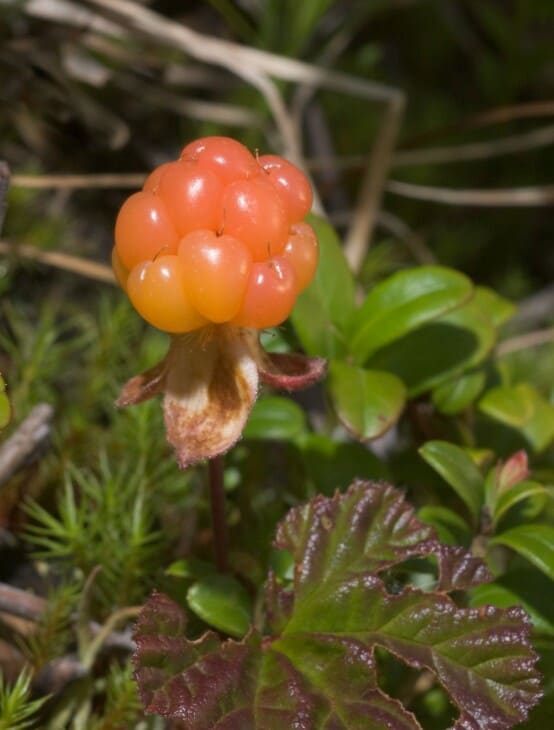
Cloudberries, as the name suggests, look like small orange clouds. These berries have a similar appearance to raspberries, and you may confuse the two. Cloudberries are also native to North America, and the fruit is also aggregated with orange-pink lobes. Cloudberries look like golden raspberries, but they taste quite different.
Cloudberries are juicy and slightly tangy, more so than raspberries. The plants also look quite different since cloudberries grow on small shrubs that only reach about 10 inches in height. The leaves look like hands, and the berries grow on straight stalks.
Cloudberries also have fewer lobes per fruit, and the lobes are bigger than those of raspberries. Cloudberries are edible and can be consumed raw. They aren’t commercially farmed in the USA and aren’t as popular as raspberries.
2. Red Mulberries (Morus rubra)
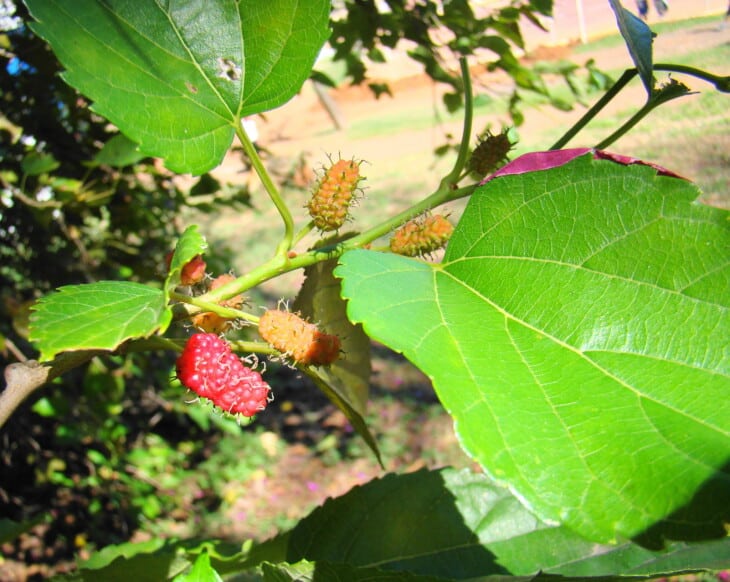
Red mulberries also resemble raspberries. These berries are another great source of vitamin C, and they grow in similar circumstances as raspberries. Red mulberries are almost as popular in North America as raspberries. Their deliciously sweet fruit is eaten fresh or made into jams or sauces.
Unlike raspberries, mulberries are multiple fruits. If you pick a mulberry, the core comes off with the fruit, whereas a raspberry’s core stays behind on the tree. Red mulberries also grow on trees instead of shrubs. The trees can grow up to 50 feet tall and has broad, grape-like leaves.
Red mulberries are edible and delicious. These trees are cultivated for their fruit and are exported worldwide. In addition, red mulberries aren’t as fragile as raspberries and have a slightly longer shelf life.
3. Thimbleberries (Rubus parviflorus)
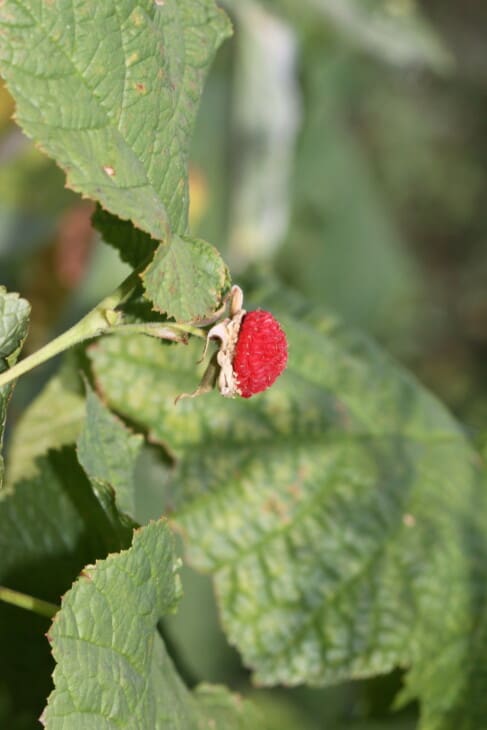
Thimbleberries grow on shrubs that resemble raspberry bushes. These shrubs grow about 6 feet tall and flourish under the same circumstances as raspberries. Thimbleberries also produce aggregate red and purple fruit that is easily mistaken for raspberries. The fruit is flatter and bigger than raspberries, though, and has a white fuzzy coating.
Thimbleberries also have a more intense flavor than raspberries. These plants may look similar to raspberries but are thornless, whereas raspberries have thorns. Fortunately, thimbleberries are edible, so you won’t regret picking the wrong fruit accidentally when indulging in these delicious and nutritious fruit.
Thimbleberries are more fragile than raspberries and aren’t cultivated commercially. However, many people prefer thimbleberries because of their intense aroma. So they are happy to stumble upon a thimbleberry bush while out in the forest.
Thimbleberry bushes are dense shrubs that grow up to 8 feet (2.5 m) tall, with canes half an inch (1.5 cm) wide. You can expect to see large clumps growing through the plant’s rootstalks, and it has no prickles. They tend to grow 2 feet taller than raspberry bushes, plus the size and texture of their leaves differ.
Thimbleberry leaves are generally more oval or triangular, while raspberry leaves are rounder or kidney-shaped.
Raspberry bush leaves are round or kidney-shaped and typically smaller than thimbleberry leaves, measuring 3 – 4 inches (7.6 – 10 cm) in length. Thimbleberry leaves have an oval or triangular shape and measure 8 inches (20.3 cm) in width and length.
Thimbleberry leaves are softer and more velvety, while raspberry leaves are more glossy and have a waxy texture. Thimbleberry leaves are also generally a lighter green color than raspberry leaves.
4. Strawberry Madrone Trees (Arbutus unedo)
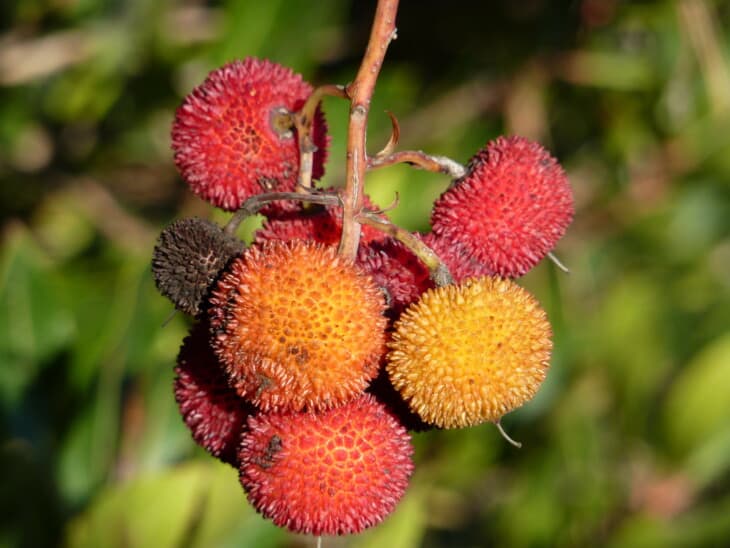
Strawberry madrone trees, or strawberry trees, may be named after another fruit. Still, the berries on this tree also look like raspberries. Strawberry madrone trees grow about 15 feet high and produce round, red fruit that looks like raspberries. The fruit have a rough surface, almost like a lichi, and are edible.
Strawberry madrone trees don’t really look like raspberry shrubs, but the fruit resemble raspberries to such an extent that it must be included in this list. Although strawberry madrone trees are usually kept for their ornamental value, the fruit of this tree is edible and delicious.
Related: Plants Similar to Strawberries
5. Kousa Dogwood Trees (Cornus kousa)
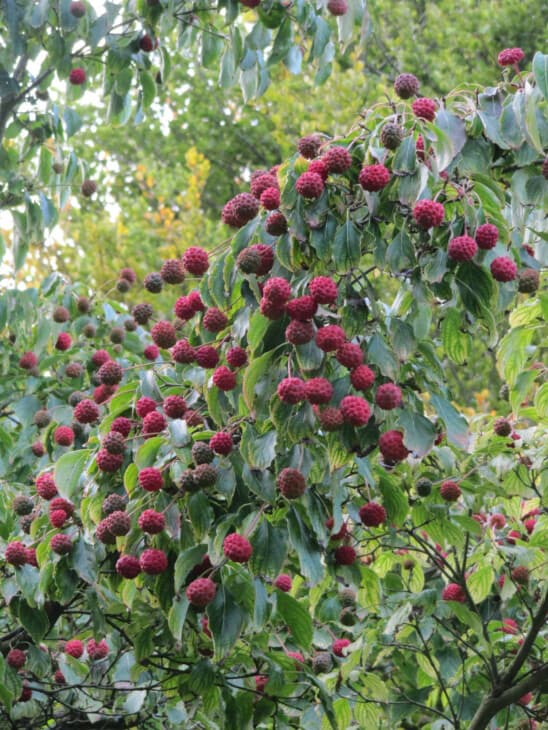
Dogwood trees, like strawberry madrone trees, are trees that produce raspberry-like fruit. Dogwood trees produce large, red fruit with a lobe-like appearance that reminds one of raspberries. Although these fruits are edible, they are described as mealy and aren’t cultivated or eaten regularly.
Kousa dogwood trees grow about 20 feet tall when exposed to the sun or 40 feet tall when kept in the shade. Kousa dogwood trees are beautiful and often kept for their ornamental value. Apart from the fruit that looks like giant raspberries, there are a few similarities between dogwood trees and raspberry shrubs.
You, therefore, shouldn’t have any difficulty identifying between the two when you have one in your garden. The fruit is also not similar enough to raspberries to be mistaken for them.
Related: 6 Trees Similar To Dogwood | Pros And Cons Of Dogwood Trees | Are Dogwood Berries Poisonous?
6. Salmonberries (Rubus spectabilis)
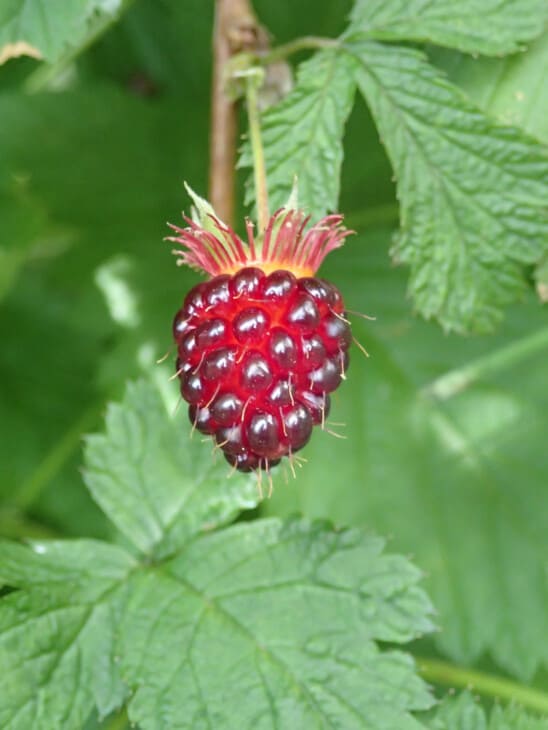
Salmonberries are another popular raspberry lookalike. These berries grow on shrubs that reach about 13 meters high and have broad, serrated leaves. Salmonberries are aggregated, like raspberries, and have a golden-pink color, almost like golden raspberries.
Salmonberry plants are bigger than raspberries, and their leaves are also a different shape. Though you won’t have too much trouble telling the plants apart, the fruit look similar enough to fool you. Fortunately, salmonberries are edible and delicious.
Described as juicy but watery, you won’t get any harm from accidentally eating salmonberries instead of raspberries. However, since they aren’t as delicious as raspberries, salmonberries aren’t really cultivated around the country.
Salmonberry is native from west-central Alaska to California and as far inland as Idaho. These edible berries have a tart-like, juicy flavor and a pinkish-orange color similar to salmon. You’ll find them in all kinds of desserts and even wines.
It has eye-catching yellow or golden arching stems that tend to form thickets, similar to other members of the genus Rubus family. The leaves alternate up the stem, similar to a raspberry bush, but typically only have three leaflets measuring 2.76 – 8.66 inches (7 – 22 cm) long.
7. Virginia Creeper (Parthenocissus quinquefolia)
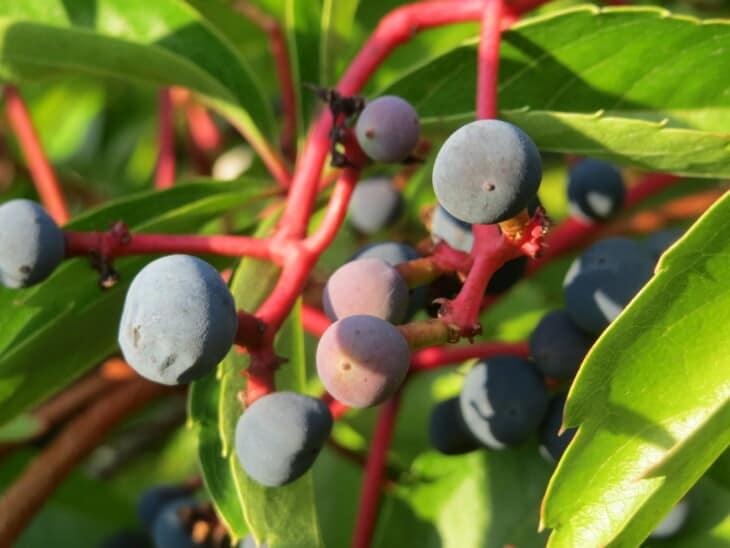
Another plant that resembles the raspberry bush is the Virginia creeper. As the name suggests, the Virginia creeper is a creeping vine that usually grows on other plants or hedges around your garden. The leaves of a Virginia creeper resemble those of a raspberry.
The plant reminds one of a raspberry bush when used as a hedge or trimmed more like a bush shape. Virginia creepers also make berries. But the berries look more like blueberries or grapes than raspberries.
Unfortunately, all parts of the Virginia creeper are toxic, including its berries, so it’s best to stay clear of anything you pick from this plant.
Related: 10 Virginia Creeper Alternatives
8. Blackberries (Rubus armeniacus)
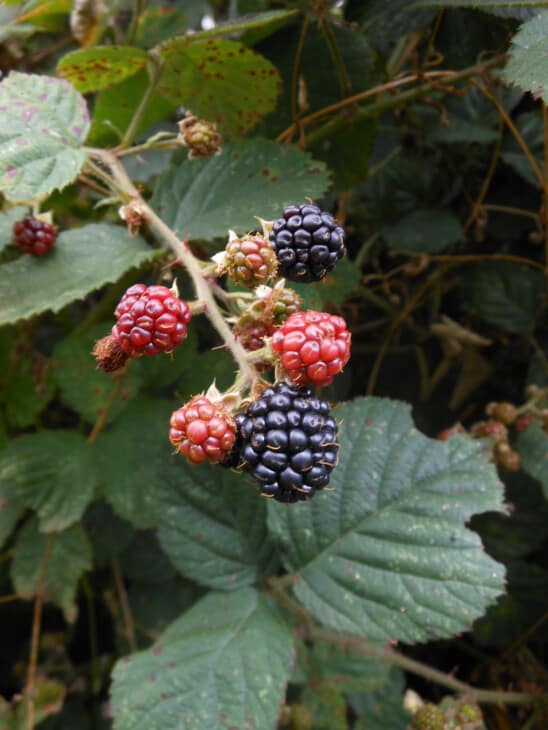
Blackberries have a close resemblance to black raspberries and are often mistaken for them. The berries, of course, look nearly identical to black raspberries in shape and size. The only difference is that blackberries are slightly bigger and shinier than raspberries.
Related: 5 Plants That Look Like Blackberries
Blackberries also have their core attached when you pick them, whereas raspberries lose their cores and are hollow. The blackberry plant also resembles a raspberry plant. It is slightly bigger and less thorny than a raspberry plant, though. You’ll have to look carefully to spot these differences.
Like raspberries, blackberries are edible, and the plants are cultivated for their fruit. These big, juicy black berries are sought after worldwide, so you won’t have problems mistaking them for raspberries and eating them.
9. Japanese Wineberry (Rubus phoenicolasius)
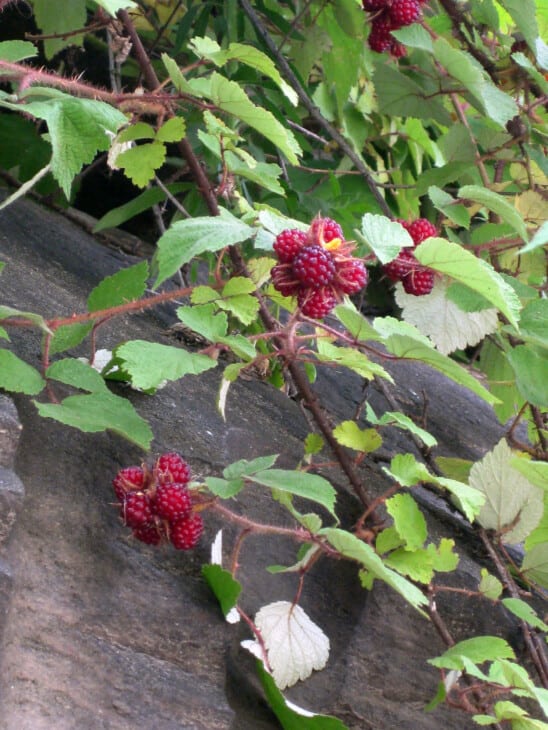
Japanese wineberry (Rubus phoenicolasius) is a perennial plant native to Japan, Korea, and China and is a species of raspberry (Rubus subgenus Idaeobatus) in the rose family.
In the same way that raspberry bushes grow well in any climate with well-draining soil, Japanese wineberries exist in several habitats, like wetland edges, forests, and open woods.
Japanese wineberry plants grow to their full height of 3.3 – 9.8 feet (1 – 3 m) within the first year, although they typically don’t produce flowers yet. During the second year, the stem will produce side shoots with three smaller leaves that are white underneath due to the density of white hairs.
You can expect to see Japanese wineberry flowers in late spring on the tips of the side shoots. They measure 0.2 – 0.4 inches (6 – 10 mm) wide and consist of five reddish-pink petals and orange-red fruit with a 0.4-inch (1 cm) diameter.
While the flowers of this plant resemble other carnivorous plants, thrive in nutrient-rich soil, and do not need to extract insect proteins to get nitrogen.
10. Loganberry (Rubus loganobaccus)
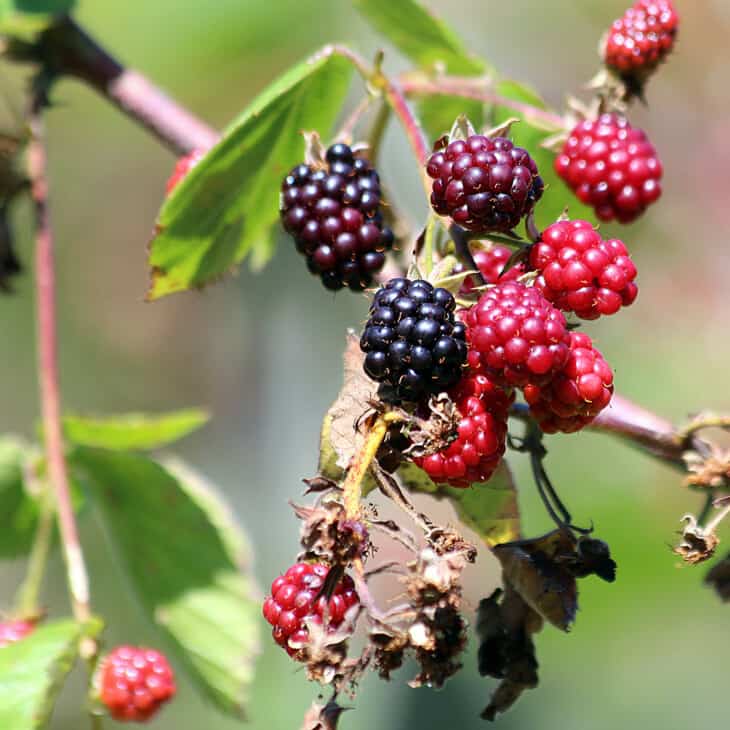
The loganberry (Rubus loganobaccus) is the result of an accident by James Harvey Logan. It is a cross between the European raspberry (Rubus idaeus) and the North American blackberry (Rubus ursinus).
Although it shares more characteristics with blackberries, the dark red fruit color often causes people to mistake them for raspberry bushes.
Loganberries are more resilient than other berries, but because berries can be at different stages of maturity on a single branch, they’re more popular for household growing than commercial use.
A loganberry bush typically produces ten vines, although its raspberry parent is more upright. Their growth cycles are unpredictable, only growing about feet in a year, while raspberry bushes grow reliably. When it comes to size, raspberry and loganberry bushes both grow to about 6.5 feet (2m).
Loganberry leaves have pointed tips and boast a more elongated appearance, whereas raspberry leaves look round and oval. Raspberry leaves are smooth and shiny green, contrary to loganberry leaves, with a rough texture thanks to their tiny white hairs.
Loganberries are “thornless” berries, meaning they do not have the characteristic thorns that many blackberry and raspberry plants have.
They are also larger than raspberries thanks to their elongated shape and pointed tip. Their texture is delicate and more susceptible to damage than raspberries.
11. Red Currant (Ribes rubrum)
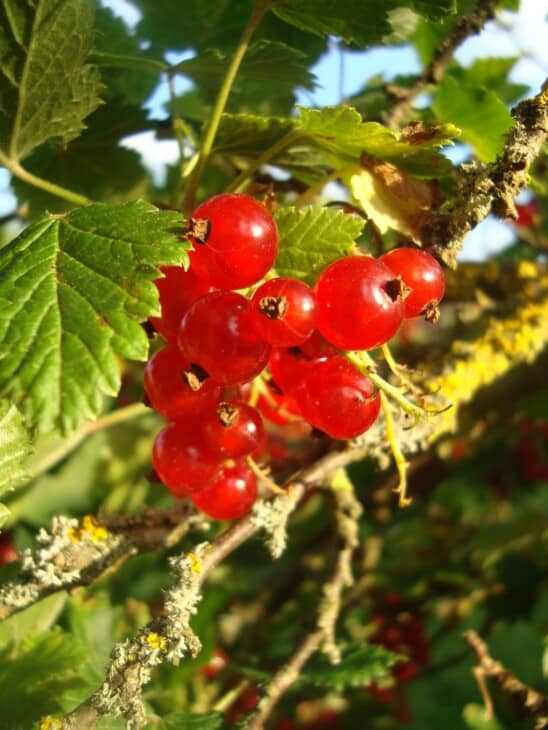
Red currant (Ribes rubrum) is a small shrub native to Europe and Asia. They produce small, red berries similar in size and shape to raspberries. Bakers will know these are some of the best berries for sweet pastries, cakes, and other delicious tarts!
Red currant and raspberry bushes can look similar in some ways because they are both woody plants with thin, branching stems and small, oval-shaped leaves that are a dark green, sometimes yellow-green color.
Despite their similarities, they have telling features that can help you differentiate between them, particularly regarding their flowers and fruit. Red currant plants produce small, pink, or white flowers in the spring, followed by small, red berries similar in size and shape to grapes.
While raspberry bushes also have white or pink flowers, their berry colors extend from red to black and purple and are larger and more oblong.
Red currants are deciduous plants that grow between 3.3 – 6.6 feet (1 – 2 m) tall and have five-lobed leaves arranged on the stem in a spiral fashion. Raspberry bushes are typically a foot shorter, but environmental conditions and genetics play a role in overall height.

